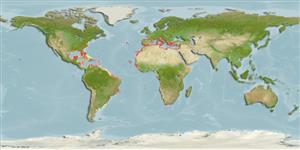Common names from other countries
Environment: milieu / climate zone / depth range / distribution range
Écologie
; profondeur 0 - 26 m (Ref. 83435). Subtropical
Distribution
Pays | Zones FAO | Écosystèmes | Occurrences | Introductions
Eastern Central Atlantic and the Mediterranean Sea: Cape Verde Island to Congo.
Length at first maturity / Taille / Poids / Âge
Maturity: Lm ? range ? - ? cm Max length : 56.5 cm SHL mâle / non sexé; (Ref. 83435); common length : 40.0 cm SHL mâle / non sexé; (Ref. 437)
Minimum depth from Ref. 104365. Subtidal (Ref. 437). Found on coral reefs (Ref. 104365).
Life cycle and mating behavior
Maturité | Reproduction | Frai | Œufs | Fécondité | Larves
Members of the class Bivalvia are mostly gonochoric, some are protandric hermaphrodites. Life cycle: Embryos develop into free-swimming trocophore larvae, succeeded by the bivalve veliger, resembling a miniature clam.
Fischer, W., G. Bianchi and W.B. Scott (eds.). 1981. (Ref. 437)
Statut dans la liste rouge de l'IUCN (Ref. 130435)
statut CITES (Ref. 108899)
Not Evaluated
Not Evaluated
Utilisations par l'homme
| FishSource |
Outils
Sources Internet
Estimates based on models
Preferred temperature
(Ref.
115969): 17.8 - 27.3, mean 21.4 (based on 1146 cells).
Catégorie de prix
Unknown.
